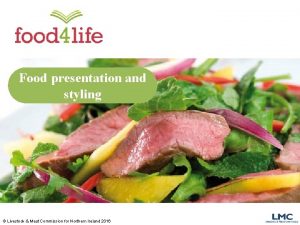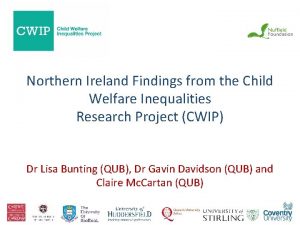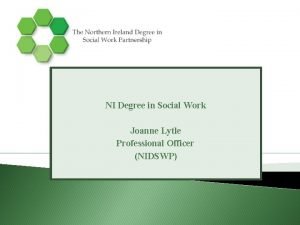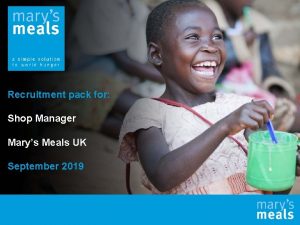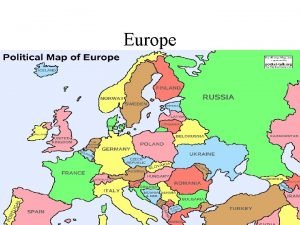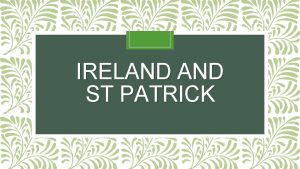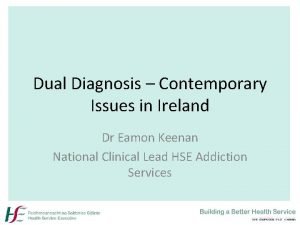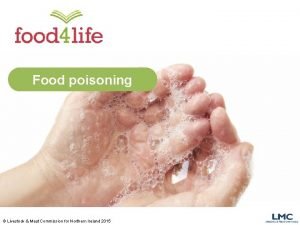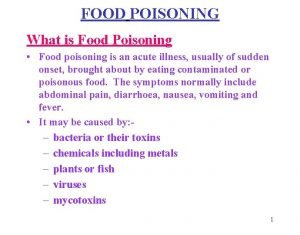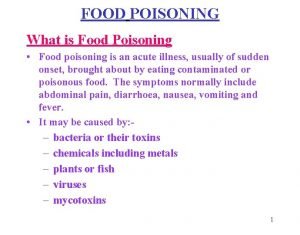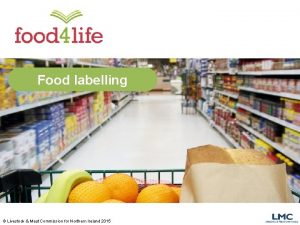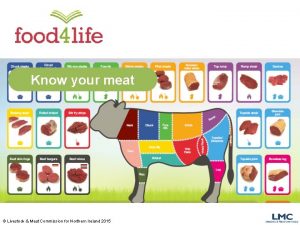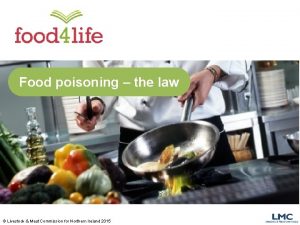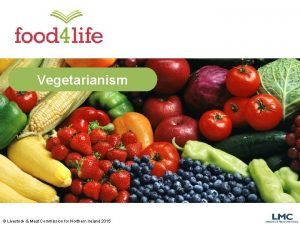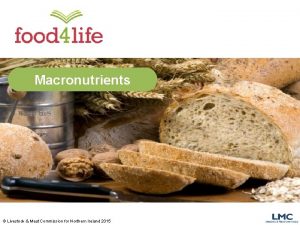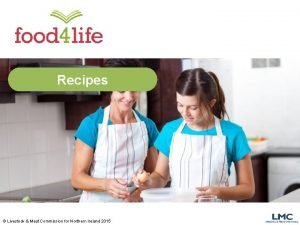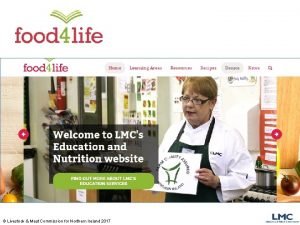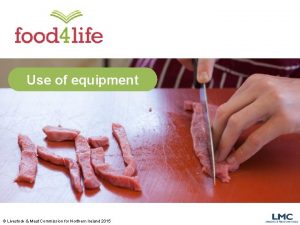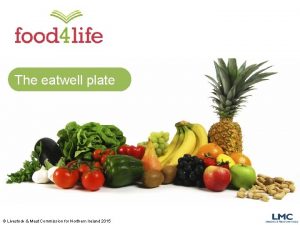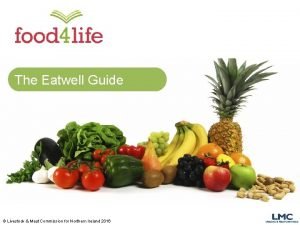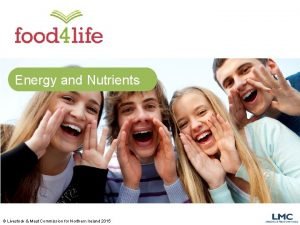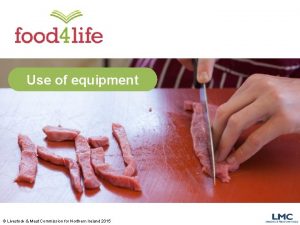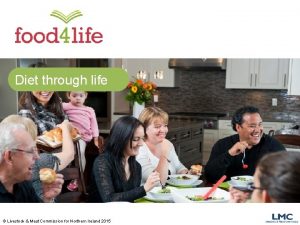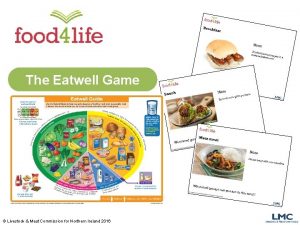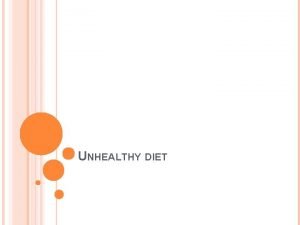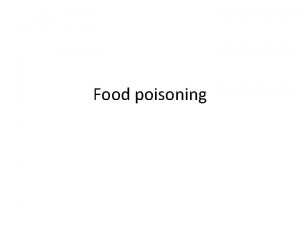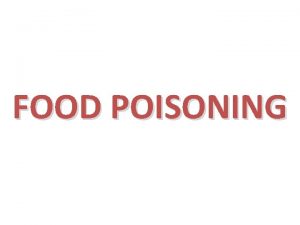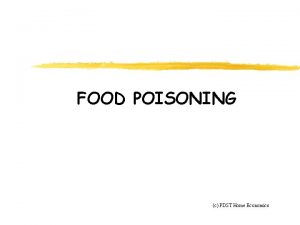Food poisoning Livestock Meat Commission for Northern Ireland


























- Slides: 26

Food poisoning © Livestock & Meat Commission for Northern Ireland 2015

Learning objectives • To recognise the seriousness of food poisoning. • To explain the conditions necessary for bacterial multiplication. • To identify high risk foods. • To determine ways to reduce the risk of bacterial multiplication. • To describe cross-contamination and identify how this can be avoided. • To review the factors affecting food poisoning. © Livestock & Meat Commission for Northern Ireland 2015

Food poisoning There are thousands of cases of food poisoning each year, many of which are not reported or recorded in official statistics. Food poisoning may result from poor domestic food preparation, or poor food processing in industry. © Livestock & Meat Commission for Northern Ireland 2015

Food poisoning statistics A recent UK study has shown: • There are more than 500, 000 cases of food poisoning a year from known pathogens; • Campylobacter was the most common foodborne pathogen, with about 280, 000 cases every year; • Salmonella is the pathogen that causes the most hospital admissions – about 2, 500 each year; • Poultry meat was the food linked to the most cases of food poisoning, with an estimated 244, 000 cases every year. Source: http: //www. food. gov. uk/news-updates/news/2014/6097/foodpoisoning © Livestock & Meat Commission for Northern Ireland 2015

Symptoms of food poisoning The symptoms of food poisoning include: • • Nausea; Vomiting; Stomach pains; Diarrhoea. The very old, the very young, or people who are already ill, are particularly at risk. © Livestock & Meat Commission for Northern Ireland 2015

Food poisoning Micro-organisms occur naturally in the environment, on cereals, vegetables, fruit, animals, people, water, soil and in the air. Most bacteria are harmless, and some are needed for medicine and food production, but a small number can cause illness. Food which is contaminated with food poisoning micro-organisms can look, taste and smell normal. © Livestock & Meat Commission for Northern Ireland 2015

Food spoilage Changes in food, either through enzyme deterioration of food or micro-organism growth, will eventually lead to the food becoming inedible or unsafe if eaten. Contaminants may be already present in the food, e. g. campylobacter in chicken or transferred to the food by humans, flies, rodents and other pests. © Livestock & Meat Commission for Northern Ireland 2015

Bacterial growth and multiplication All bacteria, including those that are harmful, have four requirements to survive and grow: • • Food; Moisture; Warmth; Time. © Livestock & Meat Commission for Northern Ireland 2015

Food Bacteria can grow and multiply on all foods. This means that all food must be stored, handled and, if appropriate, cooked correctly. However, some foods, more than others, provide the ideal conditions needed for harmful micro-organisms to grow and are known as ‘high risk foods’. High risk foods are often high in fat and protein, such as cooked meat, cooked fish, dairy and eggs. Cooked pasta and rice, although not high in fat and protein, are also regarded as high risk foods if they are not cooled quickly and stored below 5°C. © Livestock & Meat Commission for Northern Ireland 2015

High risk foods include: • Meat, meat products and poultry; • Milk and dairy products ; • Eggs – uncooked and lightly cooked; • Shellfish and seafood; • Prepared salads and vegetables; • Cooked rice and pasta. © Livestock & Meat Commission for Northern Ireland 2015

Moisture The moisture which bacteria need to survive is found in many foods. Dried foods, such as powdered milk, cereals or dried egg do not support their growth if properly stored. However, if moisture is added, any bacteria still alive in these products can quickly begin to multiply. © Livestock & Meat Commission for Northern Ireland 2015

Warmth – temperature control Poor temperature control is the most common cause of food poisoning problems. Bacteria will grow rapidly in foods, particularly high risk foods, that are left within the temperature danger zone - 5 -63°C. Bacteria do not grow or grow only very slowly, at temperatures below 5°C. They do not grow at temperatures above 63°C. © Livestock & Meat Commission for Northern Ireland 2015

Warmth – temperature control The idea behind correct temperature control is to keep food out of the danger zone and this is quite simple: • Keep hot food hot; • Keep cold food cold; • Keep prepared food out of the danger zone. © Livestock & Meat Commission for Northern Ireland 2015

Temperatures to remember • 5 -63°C – the danger zone where bacteria grow most readily. • 37°C – body temperature, optimum temperature for bacterial growth. • 8°C – maximum legal temperature for cold food, i. e. your fridge. • 5°C – the ideal temperature your fridge should be. • -18° - the temperature your freezer should be. • 70° - cooking at this temperature or above will kill most bacteria. © Livestock & Meat Commission for Northern Ireland 2015

Time When bacteria spend enough time on the right types of food at warm temperatures, they can multiply to levels that cause illness. In order to prevent this, you should: • Reduce the time bacteria have to grow by getting perishable, chilled and frozen foods home and properly stored as quickly as you can; • Keep chilled food in the fridge until just before you need to prepare or serve it; • Eat all perishable foods by their ‘use by’ date; • Use any left overs within 48 hours and re-heat until steaming hot. © Livestock & Meat Commission for Northern Ireland 2015

Preventing bacterial multiplication If you take away any one of the four requirements that bacteria need to survive, the ability of bacteria to grow and cause food poisoning is reduced. It is therefore important to: • Store, prepare and cook high risk foods carefully; • Store food either hot (above 63°C) or cold (below 5°C), never warm; • Reduce the time food is in the danger zone; • Cook food for the correct time at the right temperature – make sure it is piping hot and no pink remains in poultry. © Livestock & Meat Commission for Northern Ireland 2015

Cross-contamination The process by which bacteria are transferred from one area to another is known as cross-contamination. The main carriers of bacteria and causes of cross contamination are: • Humans; • Rubbish; • Pets and other animals; • Food, e. g. raw meat or poultry. © Livestock & Meat Commission for Northern Ireland 2015

Preventing cross-contamination Tips for preventing cross-contamination when using red meat: • Keep raw meat separate from ready – to eat food; • Do not let raw meat drip onto other food – keep it in sealed containers at the bottom of the fridge; • Never use the same chopping board for raw meat and ready-to-eat food without washing the board (and knife) thoroughly in between. Using a different coloured board for raw meat, such as red, would help prevent this; • Do not wash meat or poultry before cooking it, this will not remove harmful bacteria and may spread bacteria to work surfaces and utensils. © Livestock & Meat Commission for Northern Ireland 2015

Preventing food spoilage, contamination and poisoning Tips for buying food include: • Do not buy food past its ‘use by’ date – it is illegal for shops and supermarkets to sell out of date food; • Dented, blown or rusted cans of food should not be bought as the seal could have been damaged and bacteria might have started to grow in the can; © Livestock & Meat Commission for Northern Ireland 2015

Preventing food spoilage, contamination and poisoning • Frozen food which has frozen together in the pack should not be purchased as this indicates that it has already defrosted once; • Do not buy food where the packaging has been damaged as the food could have been contaminated; • Only shop in clean and hygienic stores. © Livestock & Meat Commission for Northern Ireland 2015

Preventing food spoilage, contamination and poisoning Tips for storing food in the home: • • Food should be unpacked as soon as possible; Old stocks of food should be used before buying: New (first in, first out theory); Store food in the correct place, i. e. dry food, in cool, dry clean places and chilled food in the refrigerator. © Livestock & Meat Commission for Northern Ireland 2015

Cooking meat safely Meat and meat products are considered high risk foods so make sure that: • When cooking beef mince, burgers, sausages, portions of pork, chicken and chicken nuggets, rolled joints and kebabs there should be no pink meat, and also be steaming hot inside. Also, the juices should run clear; • To check a whole chicken or other bird, pierce thickest part of the leg with a clean knife or skewer until the juices run out. The juices should not have any pink or red in them; • Steak or other cuts of beef or lamb can be eaten rare as long as they have been properly sealed. Sealing the meat will kill any bacteria on the outside. © Livestock & Meat Commission for Northern Ireland 2015

Cooking left-overs Leftovers should be cooled as quickly as possible ideally within 90 minutes. Separating the food into smaller containers can help. When leftovers are reheated they need to be steaming hot. Leftovers should not be reheated more than once and should be used within 1 – 2 days of cooking. © Livestock & Meat Commission for Northern Ireland 2015

Factors affecting food poisoning A number of factors can lead to food poisoning so take care when storing, preparing, cooking and serving your food. Therefore avoid: • Preparation of food too far in advance; • Storage at ambient temperature – keep food really hot or really cold; • Inadequate cooling – cool quickly and then store in the fridge if not being eaten straight away; • Inadequate reheating – make sure food is steaming hot and reheat only once; • Under cooking – make sure any bacteria present is killed. © Livestock & Meat Commission for Northern Ireland 2015

Factors affecting food poisoning • Inadequate thawing. – the heat of the oven is used to melt the ice rather than kill any bacteria; • Consuming raw food – it may be contaminated; • improper warm holding (i. e. holding ‘hot’ food below 63°C); • Infected food handlers – do not cook for your family if you are suffering from food poisoning; • Contaminated processed food; • Poor personal hygiene – always wash your hands thoroughly. © Livestock & Meat Commission for Northern Ireland 2015

Acknowledgement For further information, go to: www. food 4 life. org. uk © LMC 2015 © Livestock & Meat Commission for Northern Ireland 2015
 Livestock meat commission
Livestock meat commission Patron irlandii północnej
Patron irlandii północnej Northern ireland national flower
Northern ireland national flower Soscare northern ireland
Soscare northern ireland Nidswp
Nidswp What is the national flower of england
What is the national flower of england Northern ireland official languages irish
Northern ireland official languages irish What's 1 + 2
What's 1 + 2 Where is the source of the river shannon
Where is the source of the river shannon Protestant vs catholic
Protestant vs catholic Longest river northern ireland
Longest river northern ireland Norhern ireland flag
Norhern ireland flag Mary's meals northern ireland
Mary's meals northern ireland Northern ireland ploughing association
Northern ireland ploughing association Dr forbes
Dr forbes Northern ireland national flower
Northern ireland national flower Europe the alps
Europe the alps Education welfare
Education welfare United kingdom flower symbol
United kingdom flower symbol What is the symbol of great britain
What is the symbol of great britain What is the national flower of northern ireland
What is the national flower of northern ireland Northern ireland colleges
Northern ireland colleges Northern ireland leprechauns
Northern ireland leprechauns Dual diagnosis ireland
Dual diagnosis ireland Northern ireland national flag
Northern ireland national flag Northern ireland interpreting service
Northern ireland interpreting service Northern ireland administrative divisions
Northern ireland administrative divisions
